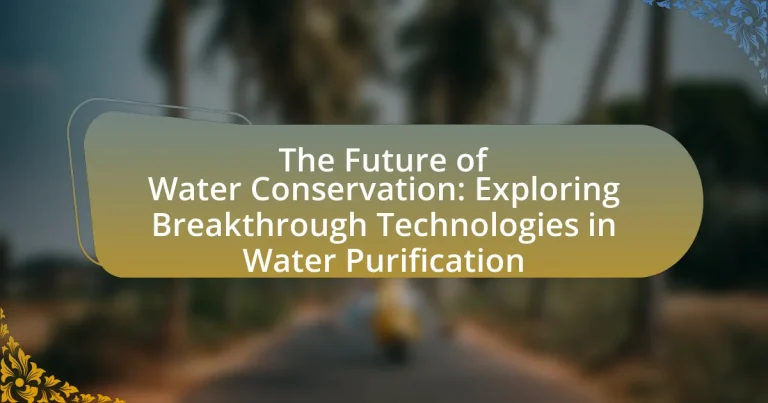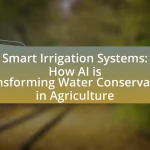The article focuses on the future of water conservation, emphasizing the role of breakthrough technologies in water purification. It highlights advancements such as membrane filtration, desalination, and smart irrigation systems, which are essential in addressing global water scarcity. Key factors driving the need for improved conservation include climate change, population growth, and the urgent demand for clean water. The article also discusses the significance of water purification for public health and sustainable management, along with emerging technologies like nanotechnology and artificial intelligence that enhance water conservation efforts. Overall, it presents a comprehensive overview of innovative practices and technologies shaping the future of water conservation.
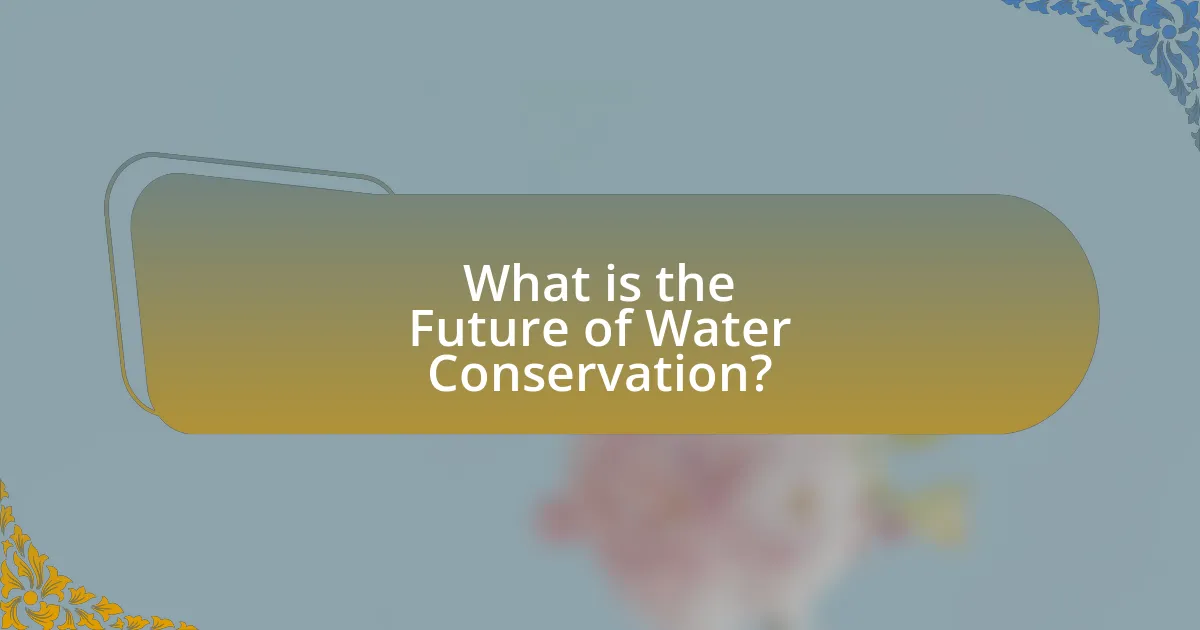
What is the Future of Water Conservation?
The future of water conservation will increasingly rely on advanced technologies and innovative practices to enhance efficiency and sustainability. Breakthroughs in water purification, such as membrane filtration, desalination, and smart irrigation systems, are expected to play a crucial role in addressing global water scarcity. For instance, the global market for desalination technology is projected to reach $29.5 billion by 2026, reflecting a growing investment in solutions that convert seawater into potable water. Additionally, the integration of IoT devices in agriculture can optimize water usage, reducing waste by up to 50%. These advancements indicate a shift towards more effective water management strategies that prioritize conservation and resource efficiency.
How is water conservation evolving in response to global challenges?
Water conservation is evolving through innovative technologies and practices that address global challenges such as climate change, population growth, and water scarcity. For instance, advancements in smart irrigation systems utilize sensors and data analytics to optimize water usage in agriculture, significantly reducing waste. According to a study by the Food and Agriculture Organization, efficient irrigation can save up to 50% of water used in traditional methods. Additionally, the development of water recycling and desalination technologies is becoming more prevalent, with countries like Israel successfully implementing these methods to meet their water needs. These approaches demonstrate a proactive response to the pressing global challenges surrounding water resources.
What are the key factors driving the need for improved water conservation?
The key factors driving the need for improved water conservation include increasing population growth, climate change, and water scarcity. Population growth leads to higher water demand for domestic, agricultural, and industrial use, putting pressure on existing water resources. Climate change exacerbates this issue by altering precipitation patterns and increasing the frequency of droughts, which further reduces water availability. Additionally, water scarcity affects approximately 2 billion people globally, highlighting the urgent need for effective conservation strategies to ensure sustainable water management and protect ecosystems.
How do climate change and population growth impact water resources?
Climate change and population growth significantly strain water resources by increasing demand and altering supply patterns. Climate change leads to altered precipitation patterns, resulting in droughts and floods that disrupt the availability of freshwater. For instance, the Intergovernmental Panel on Climate Change (IPCC) reports that many regions will experience reduced water availability due to changing climate conditions. Concurrently, population growth escalates water demand for domestic, agricultural, and industrial uses. The United Nations projects that by 2050, the global population will reach approximately 9.7 billion, intensifying competition for limited water resources. Together, these factors exacerbate water scarcity, threatening ecosystems and human livelihoods.
Why is water purification critical for conservation efforts?
Water purification is critical for conservation efforts because it ensures the availability of clean water, which is essential for sustaining ecosystems and human health. Clean water supports biodiversity by providing a safe habitat for aquatic life and maintaining the balance of natural ecosystems. According to the World Health Organization, contaminated water sources contribute to the deaths of approximately 2 million people annually, highlighting the urgent need for effective purification methods to protect both human and environmental health. Furthermore, advanced water purification technologies can reduce water scarcity by recycling wastewater, thus conserving freshwater resources and promoting sustainable water management practices.
What role does water purification play in sustainable water management?
Water purification is essential for sustainable water management as it ensures the availability of clean and safe drinking water while protecting ecosystems. By removing contaminants and pathogens, water purification processes enhance public health and reduce the burden on natural water sources. For instance, according to the World Health Organization, access to safe drinking water can prevent waterborne diseases, which affect millions globally. Furthermore, effective water purification contributes to the recycling of wastewater, allowing for its reuse in agriculture and industrial processes, thus promoting resource efficiency and reducing water scarcity.
How does effective water purification contribute to public health?
Effective water purification significantly enhances public health by removing harmful contaminants and pathogens from drinking water. This process reduces the incidence of waterborne diseases, which are responsible for millions of illnesses and deaths annually; for instance, the World Health Organization estimates that contaminated water causes over 500,000 diarrheal deaths each year. By ensuring access to clean water, effective purification methods contribute to improved overall health outcomes, decreased healthcare costs, and increased productivity within communities.
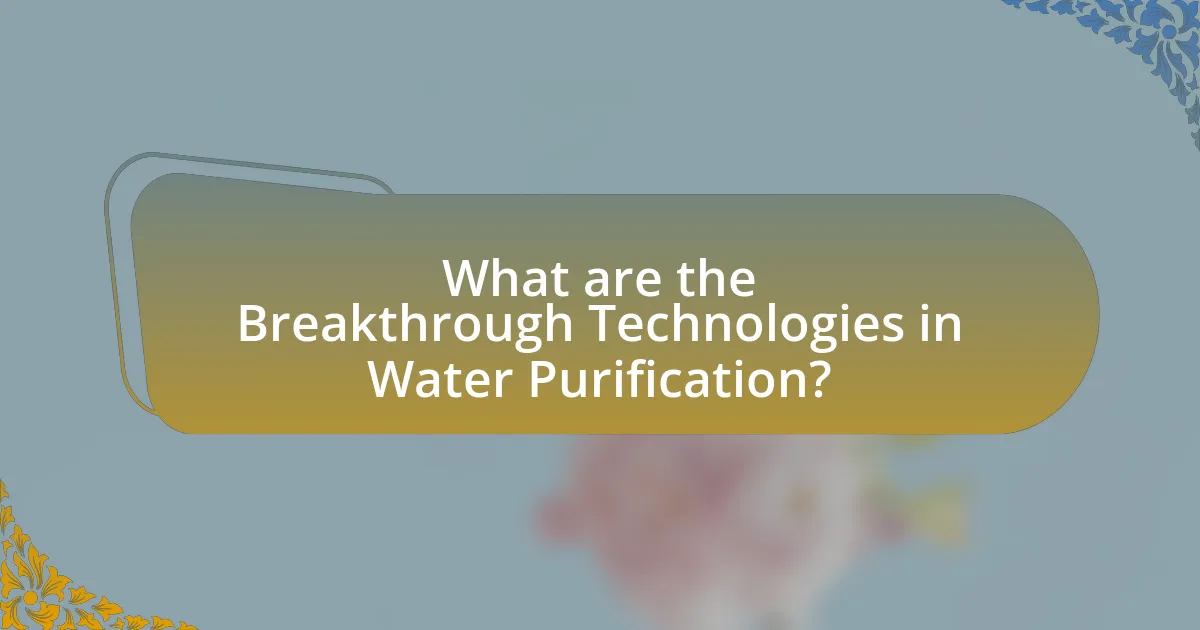
What are the Breakthrough Technologies in Water Purification?
Breakthrough technologies in water purification include advanced filtration systems, membrane technologies, and solar-powered purification methods. Advanced filtration systems, such as activated carbon and reverse osmosis, effectively remove contaminants and impurities from water. Membrane technologies, including nanofiltration and ultrafiltration, utilize semi-permeable membranes to separate particles and microorganisms from water, achieving high levels of purity. Solar-powered purification methods harness solar energy to distill water, making them sustainable and cost-effective. These technologies are validated by their increasing adoption in various regions facing water scarcity, demonstrating their effectiveness in providing clean drinking water.
What innovative technologies are currently transforming water purification?
Innovative technologies currently transforming water purification include advanced membrane filtration, ultraviolet (UV) disinfection, and nanotechnology. Advanced membrane filtration, such as reverse osmosis and nanofiltration, effectively removes contaminants at the molecular level, ensuring high-quality water. UV disinfection utilizes ultraviolet light to eliminate pathogens without the use of chemicals, providing a safe and efficient method for water treatment. Nanotechnology enhances purification processes by employing nanoparticles to target and remove specific pollutants, improving efficiency and effectiveness. These technologies are supported by research indicating significant improvements in water quality and safety, making them essential in modern water purification efforts.
How do membrane filtration systems work in water purification?
Membrane filtration systems work in water purification by using semi-permeable membranes to separate contaminants from water. These membranes allow water molecules to pass through while blocking larger particles, bacteria, and other impurities. The process typically involves applying pressure to force water through the membrane, which can be configured in various forms such as microfiltration, ultrafiltration, nanofiltration, and reverse osmosis, each targeting different sizes of contaminants. For instance, reverse osmosis can remove dissolved salts and organic molecules, achieving high levels of purification. Studies have shown that membrane filtration can effectively reduce contaminants by over 99%, making it a reliable method for producing clean drinking water.
What advancements have been made in UV disinfection methods?
Recent advancements in UV disinfection methods include the development of more efficient UV-C light sources, such as low-pressure mercury lamps and UV LEDs, which offer improved energy efficiency and longer lifespans. These innovations enhance the effectiveness of disinfection processes by increasing the intensity of UV light and reducing the time required for pathogen inactivation. For instance, studies have shown that UV LEDs can achieve similar or superior disinfection rates compared to traditional methods while consuming less energy, making them a sustainable option for water purification. Additionally, the integration of UV disinfection with advanced oxidation processes has been explored to enhance the removal of resistant microorganisms and contaminants, further improving water quality.
How do these technologies compare to traditional methods?
Breakthrough technologies in water purification, such as advanced filtration systems and membrane technologies, significantly outperform traditional methods like sedimentation and chlorination. These modern technologies offer higher efficiency in removing contaminants, achieving up to 99% removal rates for specific pollutants, compared to traditional methods that may only achieve 60-80% effectiveness. Additionally, breakthrough technologies often require less energy and produce less waste, enhancing sustainability in water conservation efforts. For instance, reverse osmosis systems can purify water with minimal chemical use, contrasting with traditional methods that rely heavily on chemical treatments.
What are the advantages of using advanced purification technologies over conventional techniques?
Advanced purification technologies offer higher efficiency, improved contaminant removal, and greater adaptability compared to conventional techniques. These technologies, such as membrane filtration and advanced oxidation processes, can achieve removal rates exceeding 99% for various pollutants, including heavy metals and pathogens, which conventional methods often struggle to eliminate effectively. For instance, reverse osmosis can remove dissolved solids and microorganisms that traditional filtration may miss, ensuring safer and cleaner water. Additionally, advanced systems often require less energy and produce less waste, making them more sustainable options for water treatment.
How do costs and efficiency differ between new and traditional purification methods?
New purification methods generally offer lower operational costs and higher efficiency compared to traditional methods. For instance, advanced technologies like membrane filtration and UV disinfection can reduce energy consumption and chemical usage, leading to cost savings. Research indicates that membrane technologies can achieve up to 90% removal efficiency for contaminants, while traditional methods like chlorination may only achieve 60-70% removal. Additionally, the initial investment in new technologies may be higher, but the long-term savings and improved water quality often justify the costs.
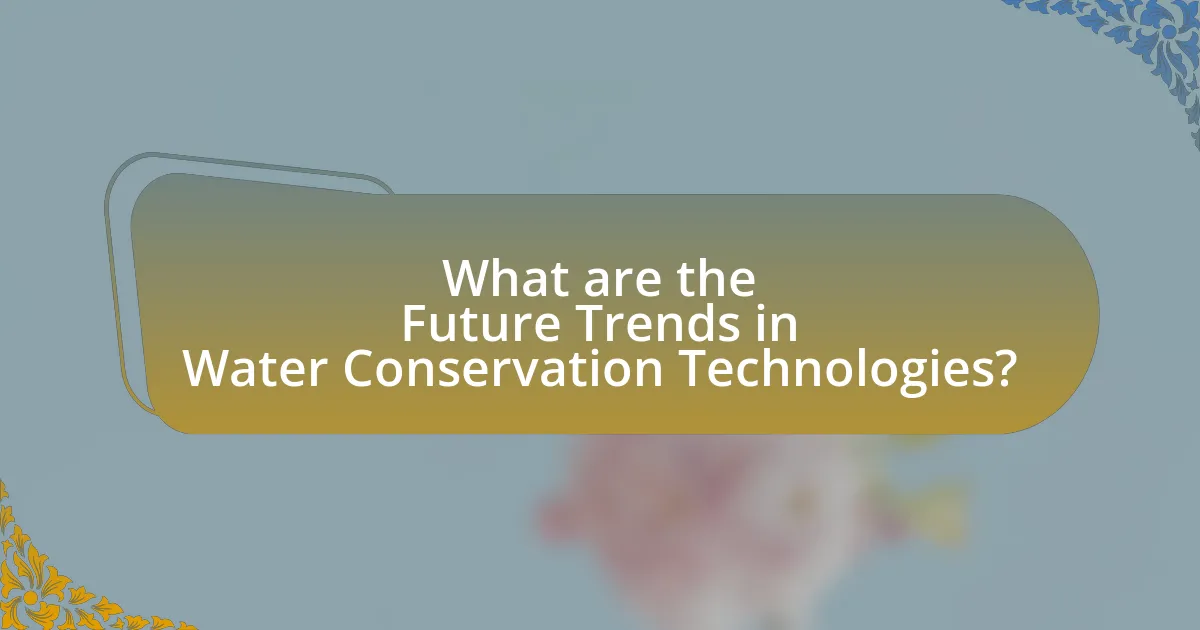
What are the Future Trends in Water Conservation Technologies?
Future trends in water conservation technologies include the increased use of smart irrigation systems, advanced water recycling methods, and the integration of artificial intelligence for monitoring water usage. Smart irrigation systems utilize sensors and weather data to optimize water application, significantly reducing waste. Advanced water recycling methods, such as membrane bioreactors and reverse osmosis, are becoming more efficient, allowing for the reuse of wastewater in agricultural and industrial applications. Additionally, artificial intelligence is being employed to analyze consumption patterns and detect leaks in real-time, enhancing overall water management. These trends are supported by the growing need for sustainable water practices due to climate change and population growth, as evidenced by reports from the United Nations indicating that water scarcity affects more than 2 billion people globally.
What emerging technologies are on the horizon for water purification?
Emerging technologies on the horizon for water purification include advanced filtration systems, nanotechnology, and solar-powered purification methods. Advanced filtration systems utilize materials like graphene and ceramic membranes to enhance contaminant removal efficiency. Nanotechnology enables the development of nanoparticles that can target and eliminate specific pollutants at a molecular level, significantly improving water quality. Solar-powered purification methods harness renewable energy to drive processes such as distillation and electrochemical treatment, making water purification more sustainable and accessible. These technologies are supported by research indicating their effectiveness in reducing contaminants and improving overall water safety.
How might nanotechnology enhance water purification processes?
Nanotechnology can enhance water purification processes by enabling the development of advanced filtration systems that effectively remove contaminants at the molecular level. For instance, nanoparticles such as silver and titanium dioxide exhibit antimicrobial properties, which can eliminate bacteria and viruses from water. Additionally, nanomaterials like carbon nanotubes and graphene oxide membranes provide high permeability and selectivity, allowing for the efficient separation of pollutants, including heavy metals and organic compounds. Research has shown that these nanomaterials can achieve purification efficiencies exceeding 90%, significantly improving the quality of treated water compared to conventional methods.
What potential does artificial intelligence hold for optimizing water conservation?
Artificial intelligence holds significant potential for optimizing water conservation by enabling precise monitoring and management of water resources. AI technologies, such as machine learning algorithms, can analyze vast amounts of data from sensors and satellite imagery to identify patterns in water usage and predict future demand. For instance, a study by the International Water Management Institute found that AI-driven irrigation systems can reduce water usage by up to 30% while maintaining crop yields. Additionally, AI can enhance leak detection in water distribution systems, minimizing waste; research indicates that smart leak detection systems can reduce water loss by 20-50%. These capabilities demonstrate that AI can effectively contribute to more sustainable water management practices.
How can communities implement these technologies effectively?
Communities can implement water purification technologies effectively by establishing collaborative partnerships with local governments, NGOs, and technology providers. These partnerships facilitate knowledge sharing, resource allocation, and funding opportunities, which are essential for successful implementation. For instance, the Water Environment Federation reported that communities that engaged in multi-stakeholder collaborations saw a 30% increase in project success rates. Additionally, communities should prioritize education and training programs to ensure that residents understand the technologies and their benefits, leading to higher adoption rates. Implementing pilot projects can also help communities assess the effectiveness of specific technologies before full-scale deployment, as demonstrated by the successful pilot programs in various cities that led to widespread adoption of advanced filtration systems.
What best practices should communities adopt for successful water conservation?
Communities should adopt practices such as implementing rainwater harvesting systems, promoting xeriscaping, and conducting regular water audits to achieve successful water conservation. Rainwater harvesting allows communities to collect and store rainwater for irrigation and non-potable uses, significantly reducing reliance on municipal water supplies. Xeriscaping, which involves landscaping with drought-resistant plants, minimizes water usage while maintaining aesthetic appeal. Regular water audits help identify leaks and inefficiencies in water use, enabling targeted improvements. According to the U.S. Environmental Protection Agency, implementing these practices can lead to water savings of up to 50% in residential areas, demonstrating their effectiveness in promoting sustainable water management.
How can public awareness and education improve water conservation efforts?
Public awareness and education can significantly improve water conservation efforts by fostering a culture of responsible water use and encouraging community engagement. When individuals are informed about the importance of water conservation, they are more likely to adopt sustainable practices, such as reducing water waste and implementing water-saving technologies. Studies show that educational programs can lead to a 20-30% reduction in water usage in communities that actively participate in conservation initiatives. For example, the California Department of Water Resources reported that public outreach campaigns resulted in a 25% decrease in urban water consumption during drought periods. This demonstrates that informed citizens can make impactful changes in their water usage behaviors, ultimately contributing to more effective water conservation strategies.
What practical steps can individuals take to support water conservation?
Individuals can support water conservation by implementing specific practices such as fixing leaks, using water-efficient appliances, and reducing outdoor water use. Fixing leaks in faucets and toilets can save significant amounts of water; for instance, a dripping faucet can waste over 3,000 gallons per year. Utilizing water-efficient appliances, like Energy Star-rated dishwashers and washing machines, can reduce water consumption by 20-50%. Additionally, reducing outdoor water use by watering gardens early in the morning or using drought-resistant plants can further conserve water resources. These actions collectively contribute to sustainable water management and help mitigate water scarcity issues.
